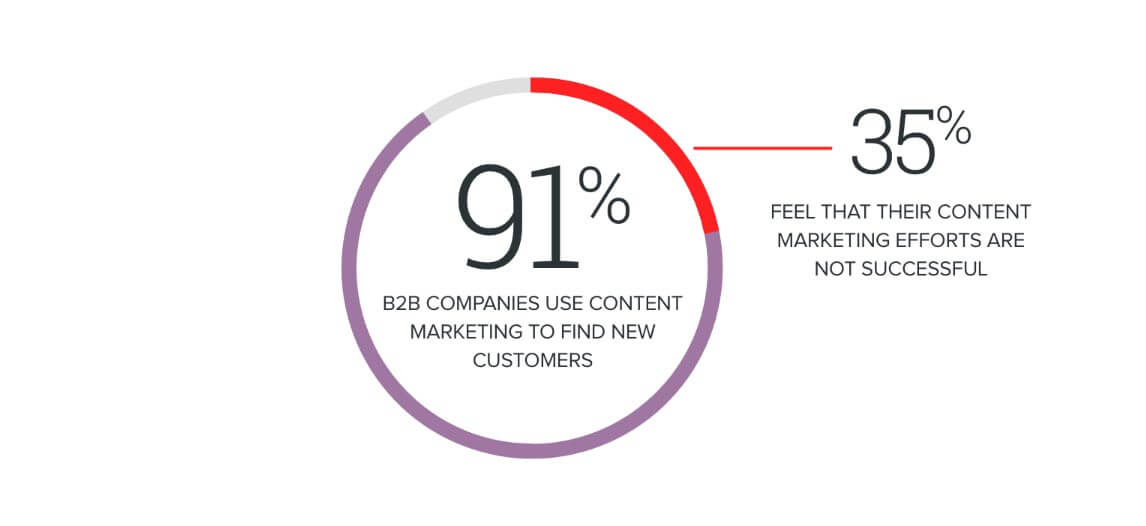Content is king in marketing, and for a B2B organization, it’s critical to build a meaningful pipeline of interest in your product or service. But what you do with the content you create is as important as the content itself.
Gated content — where users must input information in order to access the content — is a powerful B2B marketing tool that helps build a database of credible, qualified leads. By creating a “gate,” you ensure that only serious candidates will enter, cutting straight to the cream of the customer crop. There is a definitive way to do this, and there are certainly cases when content does not need to be gated (such as this article), so it’s important to have a strategy.
Creating content for more than just likes
Research shows that 91% of B2B companies use content marketing to find new customers, while 36% use it to retain existing customers. And yet, 35% of B2B marketers feel that their content marketing efforts are not successful. That’s a pretty big number, considering all the time, thought, and money that goes into creating content.

We can all agree that content is crucial in any marketing strategy. The bigger question is whether you’re creating content for general awareness or lead generation. A piece of stellar content with thousands of views and shares isn’t guaranteed to be a successful lead generator. B2B marketing is about filling the sales pipeline, not just creating buzz. Successful B2B organizations use content to generate highly qualified leads that can turn into potential customers, not to win a popularity contest. And how do they do that? Gates.
Benefits of gated content
Gated content is online material that requires something in return before the user can access it, like a name, email address, profession, interests, or more. You are starting a conversation by providing actionable insights and knowledge, and gathering interested users’ data. Some of the advantages of gating content are:
-
- User Insights
-
- Self-qualified Leads
-
- Content Marketing Payoff
Knowing when to gate
There are some limitations with gating. Obviously, restricting access results in smaller audience reach. For B2B purposes, this can be beneficial, but for a product or business launch, you may want to make a bigger splash. Gated content doesn’t work as well for SEO purposes, and it should only be used for unique and proprietary content and insights, which requires additional effort on your part. You have to put the work in to make it worth the customer’s time.
At the start of the funnel (the awareness stage), it can be beneficial to reach a broader audience with non-gated content. As audiences get further down the funnel (the consideration stage), gated content that solves a specific need or challenge can help turn that interested viewer into a lead. Consider this: if you can improve a customer’s business before your first conversation, they’ll be more confident and interested in you. If you create a barrier to entry for that information, they’ll be more committed.
Gate the right content
For your audience to give you their valuable personal information, you have to give them something that they want in return. Every individual has a different definition of what is valuable to them, but in general, if you deliver on these three needs, you will meet their expectations:
- It should be relevant to your audience. Your content needs to speak to their role, their needs, their industry, or something they can relate to.
- It should be valuable enough to opt-in, share, and reference. Gated content can’t be generic or readily available elsewhere. Your insights must distinctive and give your viewers fresh perspective.
- It should be actionable —providing tips they can implement. There’s nothing worse than getting advice you can’t act on. Make sure your content isn’t out of reach for your audience.
Some types of gated content are:
Wondering what to gate? This is a fun “Should I Gate” guide created by HubSpot:
https://blog.hubspot.com/marketing/should-i-gate-this-content-flowchart
Only gate if you can follow through
If you don’t have an automated follow-up system in place, gating your content may be a bad idea. You should be able to manage the data and communicate further with the leads you have attracted. If you don’t, you’ll waste resources converting leads and letting them fizzle out. Not to mention, it will create a bad experience for interested leads, if they express their interest and forgotten.
You should have at least two things in place before you start.
- An automated email system that delivers constant content to keep the relationships alive.
- Communications triggers that automatically deliver tailored messages according to whether the lead is warm, hot, or cold.
At minimum, make sure that someone in your organization can personally reach out. If you’re not getting enough leads to make automation worth it, you may decide it’s not yet time to gate.
Progressive profiling gets you more insight
Progressive profiling allows you to capture lead data without asking for too much, too early. Using marketing automation tools, progressive profiling is done through your gate forms. When a visitor fills out a form for the first time, they are required only to complete a few form fields. The next time, a few more fields.
The best way to build a lead is to start simply. Ask them for their name and email at the first gate. This is an unintimidating way for them to confirm their interest. When they request more content or communications, ask for additional details (one to two fields of information at a time). You can keep going with this pattern as you continue to narrow down their interests and needs, further tailoring what you serve them. In this way, you are building a mutual relationship, establishing trust, and slowly narrowing the sales funnel until you close.
Get your gates going
If you’ve been having trouble generating valuable leads and getting the payoff from content marketing efforts for your B2B organization, it’s time to invest in gated content. You’ll find that you will spend less time getting more business, and you’ll have an incredible new asset—customer data.
People value what they work for, and entering basic information into a form is a low cost for them that could lead to high rewards for you. It’s time to create the boundaries that will open up new opportunities for your business.






